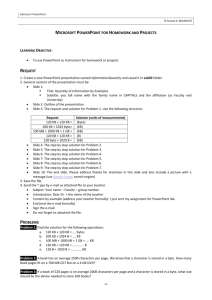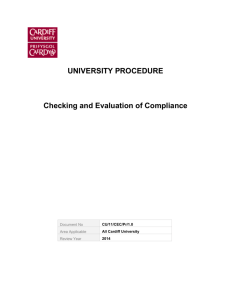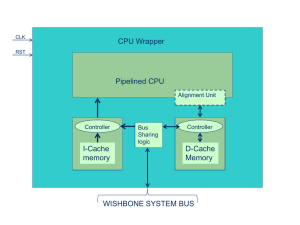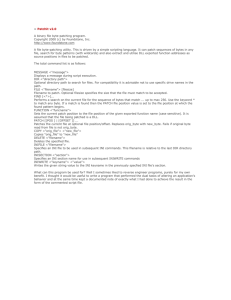AES: Rijndael Cryptosystem
advertisement
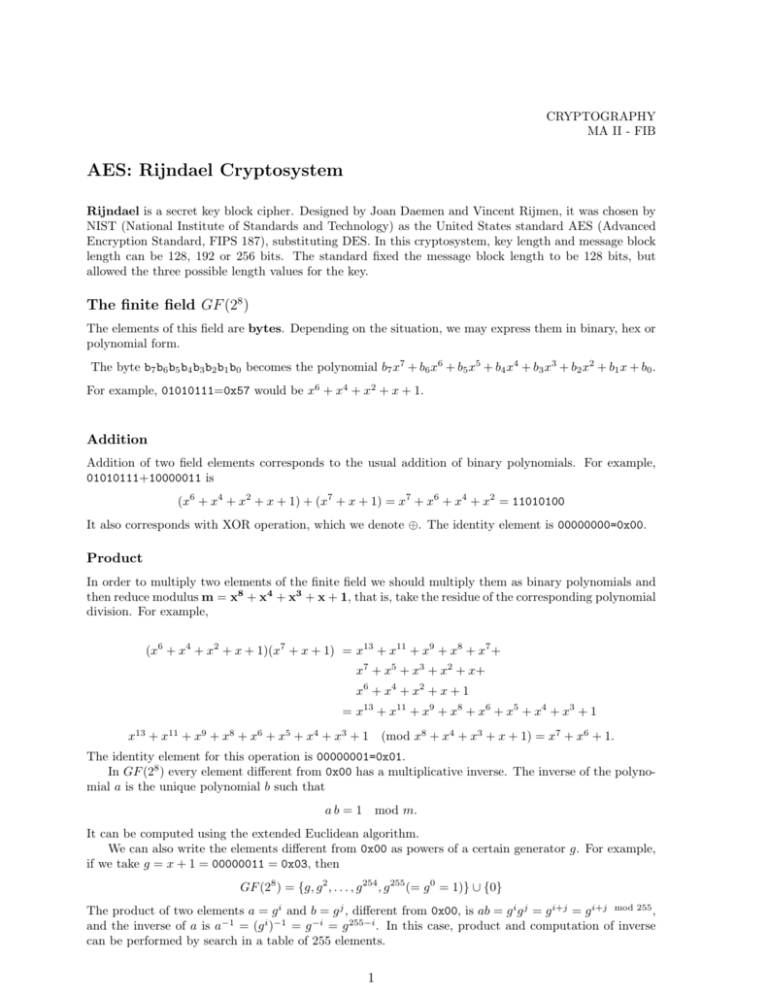
CRYPTOGRAPHY
MA II - FIB
AES: Rijndael Cryptosystem
Rijndael is a secret key block cipher. Designed by Joan Daemen and Vincent Rijmen, it was chosen by
NIST (National Institute of Standards and Technology) as the United States standard AES (Advanced
Encryption Standard, FIPS 187), substituting DES. In this cryptosystem, key length and message block
length can be 128, 192 or 256 bits. The standard fixed the message block length to be 128 bits, but
allowed the three possible length values for the key.
The finite field GF (28 )
The elements of this field are bytes. Depending on the situation, we may express them in binary, hex or
polynomial form.
The byte b7 b6 b5 b4 b3 b2 b1 b0 becomes the polynomial b7 x7 + b6 x6 + b5 x5 + b4 x4 + b3 x3 + b2 x2 + b1 x + b0 .
For example, 01010111=0x57 would be x6 + x4 + x2 + x + 1.
Addition
Addition of two field elements corresponds to the usual addition of binary polynomials. For example,
01010111+10000011 is
(x6 + x4 + x2 + x + 1) + (x7 + x + 1) = x7 + x6 + x4 + x2 = 11010100
It also corresponds with XOR operation, which we denote ⊕. The identity element is 00000000=0x00.
Product
In order to multiply two elements of the finite field we should multiply them as binary polynomials and
then reduce modulus m = x8 + x4 + x3 + x + 1, that is, take the residue of the corresponding polynomial
division. For example,
(x6 + x4 + x2 + x + 1)(x7 + x + 1) = x13 + x11 + x9 + x8 + x7 +
x7 + x5 + x3 + x2 + x+
x6 + x4 + x2 + x + 1
= x13 + x11 + x9 + x8 + x6 + x5 + x4 + x3 + 1
x13 + x11 + x9 + x8 + x6 + x5 + x4 + x3 + 1
(mod x8 + x4 + x3 + x + 1) = x7 + x6 + 1.
The identity element for this operation is 00000001=0x01.
In GF (28 ) every element different from 0x00 has a multiplicative inverse. The inverse of the polynomial a is the unique polynomial b such that
ab = 1
mod m.
It can be computed using the extended Euclidean algorithm.
We can also write the elements different from 0x00 as powers of a certain generator g. For example,
if we take g = x + 1 = 00000011 = 0x03, then
GF (28 ) = {g, g 2 , . . . , g 254 , g 255 (= g 0 = 1)} ∪ {0}
The product of two elements a = g i and b = g j , different from 0x00, is ab = g i g j = g i+j = g i+j mod 255 ,
and the inverse of a is a−1 = (g i )−1 = g −i = g 255−i . In this case, product and computation of inverse
can be performed by search in a table of 255 elements.
1
Input of message and key
We convert the plaintext into a bit sequence of length multiple of 128, which is divided in blocks of
length 128. Bits of such a block are arranged in a 4 × 4 matrix, called state. The arrangement
is done by columns and coefficients of the matrix are bytes. Namely, if the block is the byte array
a00 a10 a20 a30 a01 a11 a21 a31 . . . a23 a33 , then the state is:
a00
a10
a20
a30
a01
a11
a21
a31
a02
a12
a22
a32
a03
a13
a23
a33
Similarly, key bits are placed in a matrix having 4 rows and Nk columns. The number Nk of columns
will be 4, 6 or 8, depending on the key length being 128, 192 or 256, respectively. For example, if the key
has length 192 we have Nk = 6 and if we represent the key as the byte sequence k00 k10 k20 k30 k01 . . . k25 k35 ,
then the matrix is:
k00 k01 k02 k03 k04 k05
k
k11 k12 k13 k14 k15
clau = 10
k20 k21 k22 k23 k24 k25
k30 k31 k32 k33 k34 k35
Enciphering algorithm
There is an initial transformation followed by Nr rounds. The number of rounds depends on Nk:
Nk
Nr
4
10
6
12
8
14
Through the KeyExpansion process, which is described below, Nr + 1 round subkeys Ki are generated
from the key K. These round subkeys are 4×4 matrices. The first one is used in the initial transformation
and then one in each round.
Let M be the 128 bit message block we want to encipher, represented as a 4 × 4 state matrix as
above. The enciphering algorithm has the following steps:
estat = AddRoundKey(M, K0 )
For i=1 to Nr − 1
estat = Roundi (estat, Ki )
EndFor
C = Roundfinal (estat, KNr )
where C is the ciphertext. For i = 1, ..., Nr − 1 the round Roundi consists of the following operations:
estat
estat
estat
estat
= ByteSub(estat)
= ShiftRow(estat)
=MixColumn(estat)
= AddRoundKey(estat, Ki )
The Roundfinal omits the third one:
estat = ByteSub(estat)
estat = ShiftRow(estat)
estat = AddRoundKey(estat, KNr )
The input for the AddRoundKey function are two 4 × 4 matrices and then it performs XOR to
their coefficients:
A ⊕ B = aij ⊕ bij i,j
2
ByteSub
This function operates byte by byte as follows:
1) For each byte different from 0x00 take the inverse in GF (28 )
2) Apply the following affine transformation (taking into account that the operations are mod 2): the
image of the byte b7 b6 b5 b4 b3 b2 b1 b0 is the byte u7 u6 u5 u4 u3 u2 u1 u0 , where
1
b0
1 0 0 0 1 1 1 1
u0
u1 1 1 0 0 0 1 1 1 b1 1
u2 1 1 1 0 0 0 1 1 b2 0
u3 1 1 1 1 0 0 0 1 b3 0
+
=
u4 1 1 1 1 1 0 0 0 b4 0 .
u5 0 1 1 1 1 1 0 0 b5 1
u6 0 0 1 1 1 1 1 0 b6 1
0
b7
0 0 0 1 1 1 1 1
u7
ShiftRow
The ShiftRow function leaves the first row unchanged and rotates to the left each other row of the state
matrix: the second row is rotated one position, the third row two positions and the forth row three
positions. That is, if rows are numbered from 0 to 3, the i−th row is rotated i positions to the left.
MixColumn
In this function, operations are performed over columns of the state matrix. Each column is considered as
a polynomial of degree < 4 with coefficients in GF (28 ). This polynomial is multiplied by the polynomial
c(Y ) =0x03Y 3 +0x01Y 2 +0x01Y +0x02 and finally we take the polynomial remainder of the division by
Y 4 + 1. This is an endomorphism of the polynomial vector space and therefore it can be computed
through matrix multiplication. Concretely, if (v0i , v1i , v2i , v3i ) is a column of the state, its image under
the MixColumn function is (w0i , w1i , w2i , w3i ), where
v0i
0x02 0x03 0x01 0x01
w0i
w1i 0x01 0x02 0x03 0x01 v1i
w2i = 0x01 0x01 0x02 0x03 v2i .
0x03 0x01 0x01 0x02
w3i
v3i
KeyExpansion
The key K is arranged in a 4×Nk matrix. Its columns are denoted by clau(0), clau(1), ..., clau(Nk − 1).
As we said before, the KeyExpansion function generates Nr + 1 subkeys. These subkeys are stored in
matrix W, having 4 rows and 4(Nr + 1) columns. W(0), . . . , W(3) will be the subkey K0 , W(4), . . . , W(7)
the subkey K1 and so on. Columns of W are successively computed from the initial ones, according to
the following algorithm 1 :
For i = 0 to Nk − 1
W(i) = clau(i)
EndFor
For i = Nk to 4 ∗ (Nr + 1) − 1
temp = W(i − 1)
If i = 0 mod Nk
temp = ByteSub(RotByte(temp)) ⊕ Rcon(i/Nk)
EndIf
If Nk = 8 i i = 4 mod Nk
temp= ByteSub(temp)
EndIf
W(i) := W(i − Nk) ⊕ temp
EndFor
1
ByteSub operates on each element of the column.
3
The RotByte function is rotation: column (a, b, c, d) becomes column (b, c, d, a). On the other hand,
Rcon(i) stands for the column (xi−1 , 0, 0, 0), using polynomial notation, which means that we should
take the remainder of division by m(x).
Deciphering algorithm
The deciphering algorithm has the same structure as the enciphering one: an initial transformation followed by Nr rounds. We use round subkeys obtained from InvKeyExp, denoted by invK0 , invK1 , . . . , invKNr .
Let C be the block to decrypt, arranged as a 4 × 4 matrix. The deciphering algorithm is:
estat = AddRoundKey(C, invKNr )
For i = Nr − 1 to 1
estat = InvRoundi (estat, invKi )
EndFor
M = InvRoundfinal (estat, invK0 )
For i = Nr − 1, . . . , 1, the transformations in InvRoundi are
estat
estat
estat
estat
=
=
=
=
InvByteSub(estat)
InvShiftRow(estat)
InvMixColumn(estat)
AddRoundKey(estat, invKi )
And in InvRoundfinal we have:
estat = InvByteSub(estat)
estat = InvShiftRow(estat)
estat = AddRoundKey(estat, invK0 )
The new functions are precisely the inverses of the ones we have in the enciphering algorithm:
• InvByteSub. First we have to apply the inverse affine transformation y = A−1 (x − v), where
0 0 1 0 0 1 0 1
1 0 0 1 0 0 1 0
0 1 0 0 1 0 0 1
1 0 1 0 0 1 0 0
−1
A =
0 1 0 1 0 0 1 0
0 0 1 0 1 0 0 1
1 0 0 1 0 1 0 0
0 1 0 0 1 0 1 0
Then, if the result is not 0x00, we should take inverses in GF (28 ).
• InvShiftRow. Apply to each row the same rotation as before, but now to the right.
• InvMixColumn. Each column is now multiplied by the inverse polynomial
d(Y ) = 0x0B Y 3 + 0x0D Y 2 + 0x09 Y + 0x0E.
Using matrices:
v0i
0x0E
v1i 0x09
v2i = 0x0D
v3i
0x0B
0x0B
0x0E
0x09
0x0D
0x0D
0x0B
0x0E
0x09
0x09
w0i
w1i
0x0D
0x0B w2i
0x0E
w3i
.
• InvKeyExp. Apply to the key K the KeyExpansion function, to obtain a matrix W . The initial 4
and the final 4 columns of W remain unchanged. To the remaining ones, we apply InvMixColumn.
Therefore, invK0 = K0 , invKNr = KNr , and invKi = InvMixColumn(Ki ) for 1 ≤ i ≤ Nr − 1.
4
Messages and padding
Messages will be byte sequences. Therefore, 16 bytes are needed to fill a state matrix corresponding to
a 128 bit block. We add the same kind of padding as in SHA, now for 128 bit blocks.
Implementation: signatures
Define the class aes with the following methods:
public static byte[ ][ ][ ] keyExpansion(BigInteger K , int Nk, int Nr)
input:
output:
K is an integer representing the key, Nk is the number of columns of the key and Nr is
the number of rounds;
list of the Nr + 1 enciphering subkeys, first index refers to subkey, second one to the
subkey row and the last one to the subkey column.
public static byte[ ][ ][ ] invKeyExpansion (BigInteger K, int Nk, int Nr)
input:
output:
K is an integer representing the key, Nk is the number of columns of the key and Nr is
the number of rounds;
list of Nr + 1 deciphering subkeys, first index refers to subkey, second one to the
subkey row and the last one to the subkey column.
public static byte byteSub(byte subestat)
input:
output:
subestat is a byte;
a byte, obtained applying ByteSub to subestat.
public static byte invByteSub (byte subestat)
input:
output:
subestat is a byte;
a byte, obtained applying InvByteSub to subestat.
public static byte[ ][ ] shiftRow(byte[ ][ ] estat)
input:
output:
estat is a 4 × 4 byte matrix;
a 4 × 4 byte matrix, obtained applying ShiftRow to estat.
public static byte[ ][ ] invShiftRow(byte[ ][ ] estat)
input:
output:
estat is a 4 × 4 byte matrix;
a 4 × 4 byte matrix, obtained applying InvShiftRow to estat.
public static byte[ ][ ] mixColumn(byte[ ][ ] estat)
input:
output:
estat is a 4 × 4 byte matrix;
a 4 × 4 byte matrix, obtained applying MixColumn to estat.
public static byte[ ][ ] invMixColumn(byte[ ][ ] estat)
input:
output:
estat is a 4 × 4 byte matrix;
a 4 × 4 byte matrix, obtained applying InvMixColumn to estat.
5
public static byte[ ][ ] addRoundKey(byte[ ][ ] estat, byte[ ][ ] Ki )
input:
output:
estat and Ki are 4 × 4 byte matrices;
a 4 × 4 byte matrix, obtained adding matrices estat and Ki bit to bit.
public static byte[ ][ ] rijndael(byte[ ][ ] estat, byte[ ][ ][ ] W, int Nk, int Nr)
input:
output:
estat is a 4 × 4 byte matrix, Nk is the key length divided by 32, Nr is the number of
rounds and W is the matrix storing the enciphering subkeys;
a 4 × 4 byte matrix, obtained applying the enciphering algorithm to estat.
public static byte[ ][ ] invRijndael(byte[ ][ ] estat, byte[ ][ ][ ] InvW, int Nk, int Nr)
input:
output:
estat is a 4 × 4 byte matrix, Nk is the key length divided by 32, Nr is the number of
rounds and InvW is the matrix storing the deciphering subkeys;
a 4 × 4 byte matrix, obtained applying the deciphering algorithm to
public static byte[] xifrarAES (byte[] M, BigInteger K, int Lk)
input:
output:
M is a byte list representing the message to encipher, K is an integer representing the
key and Lk is the key length (128, 192 or 256);
byte list representing the cryptogram obtained by enciphering the message M (with
added padding) in CBC mode with key K.
public static byte[] desxifrarAES (byte[] C, BigInteger K, int Lk)
input:
output:
C is a byte list representing the cryptogram, K is an integer representing the key and
Lk is the key length (128, 192 or 256);
byte list representing the message obtained after deciphering and padding removal.
Test values
In FIPS 197 you can find detailed examples for keyExpansion, rijndael and invRijndael.
6


